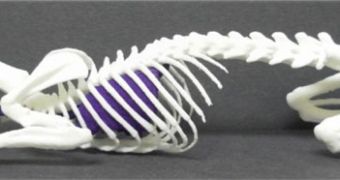We suppose that, having seen 75% of a man's skull get replaced by a 3D-printed implant, we shouldn't be surprised to hear that complete skeleton models can be created that way.
There is a certain medical procedure that greatly helps doctors figure out if a person has bone fractures and how to mend them.
Said procedure is called a CT scan and produces a 3D virtual model of the skeleton.
CT scans can be used on animals just as easily as on humans.
Now we learn that it is quite easy to use a 3D model produced by such scans to make models of complete skeletons.
Indeed, the one above was made by taking a CT scan of an anesthetized rat and sending the data to a 3D printer.
Evan Doney, an engineering student working in the lab of Matthew Leevy, got the idea. A conversation with an ear, nose, and throat specialist during an office visit (for a sinus problem) led to the whole 3D-printed skeleton matter.
“At first I didn’t really know what the killer app would be, I just knew it would be really cool,” Leevy said.
“I actually got out my computer and showed [the specialist] some slides, and by the end of it we were collaborating.”
Education is one area where the models could help, and they would be cheaper to make too, compared to high-quality casts of a human skull that cost hundreds of dollars. Furthermore, Leevy envisions other uses.
“We can also use our approach to print skulls in which various anatomical structures are printed in a separate color, or in glow in the dark plastic, to highlight them and further facilitate the learning process,” he explains.
We can definitely see this evolving into 3D-printed prosthetics and actual substitute for bone tissue during surgeries, though 3D Printers would have to evolve to a material other than plastic first.

 14 DAY TRIAL //
14 DAY TRIAL //